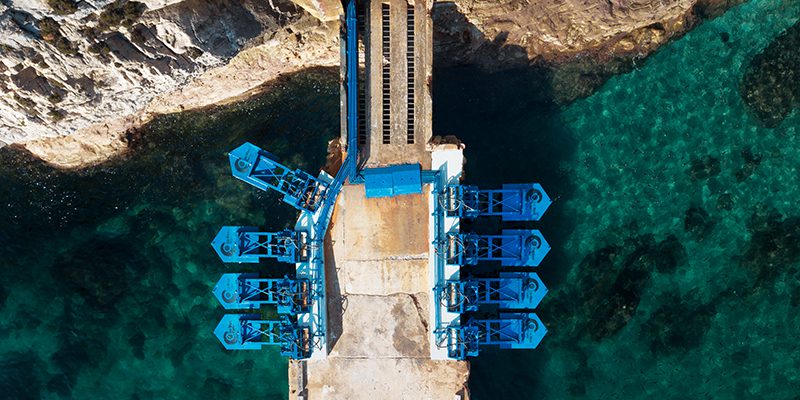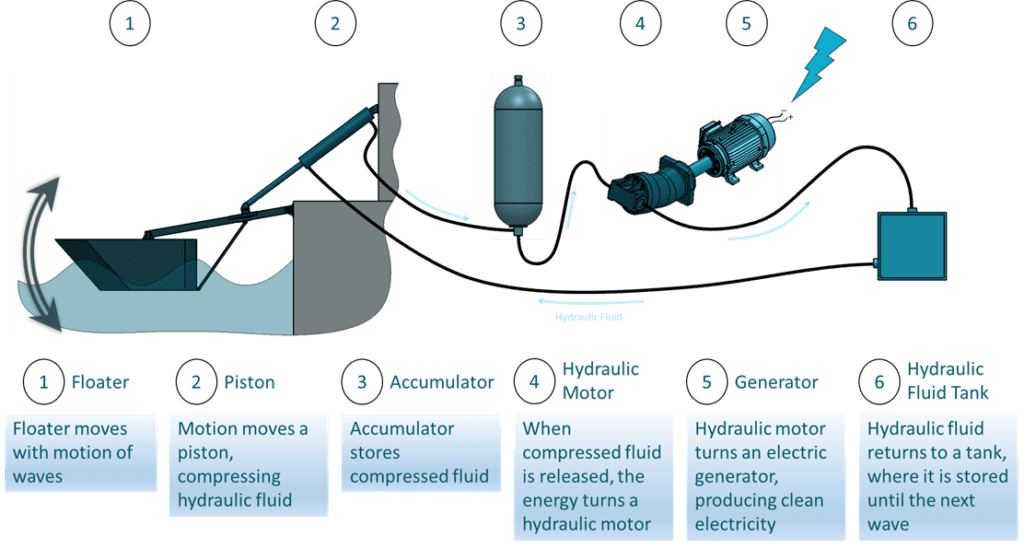Pioneering U.S. Wave Energy Power Plant Unveiled
Credit to Author: Sonal Patel| Date: Thu, 12 Jan 2023 18:09:09 +0000

One of the first U.S.-based wave energy power plants is set to be deployed at AltaSea’s 35-acre campus located at the Port of Los Angeles. Israeli firm Eco Wave Power, which unveiled the project on Jan. 12, said the AltaSea pilot would help the company make inroads in the U.S.
Eco Wave’s onshore wave energy technology harvests energy drawn from waves at heights of 0.5 meters ( 20 inches) using floaters and energy converters. “More precisely, the movement of the floaters compresses and decompresses hydraulic pistons, which transmit bio-degradable hydraulic fluid into land-located accumulators,” the company explained. “In the accumulators, pressure is being built. This pressure rotates a hydraulic motor, which rotates the generator, and then the electricity is transferred into the grid via an inverter.” The whole operation is controlled and monitored by a smart automation system. “Also, when the waves are too high for the system to handle, the floaters automatically rise above the water level and stay in the upward position until the storm passes. Once the storm passes, the floaters return to operation mode,” it said.

An Upgraded Wave Energy Unit
While the Port of Los Angeles project is the first in the U.S. for Eco Wave, the company is spearheading several projects around the world. Its first commercial offering is a 100-kW project in the Jaffa Port in Israel, which Eco Wave developed in partnership with EDF Energies Nouvelles Israel. The project is in the final stages of grid connection and readying to become operational. “Once the power station is officially connected to the grid, this will be the first time in the history of Israel that electricity from sea waves will be sent to Israel’s national electrical grid. We expect that our success at the EWP-EDF 1 project will enable us to gradually position wave energy as a viable renewable energy source,” Eco Wave Power Founder and CEO Inna Braverman said in December.
A project to build arrays of up to 20 MW in four locations owned and operated by the Port of Leixões, Portugal, is also under development. In Spain, Eco Wave plans to develop a wave energy plant of up to 2 MW at Port Adriano. The company in December signed an agreement with OREN Ordu Enerji for the potential construction of a 77-MW installation in Turkiye. If built, the Turkish project could become the world’s largest wave power station. In total, Eco Wave’s project pipeline amounts to 404.7 MW.

The AltaSea pilot, meanwhile, will leverage a unit relocated from a proof-of-concept project in Gibraltar. Under the demonstration between 2016 and January 2022, Eco Wave operated a grid-connected array as part of a power purchase agreement with Gibraltar’s government and state-owned electric utility GibElectric.
The AltaSea unit, comprising a floater and an energy conversion unit, arrived at the port on Dec. 14. It was “successfully modified and upgraded” within a year before being transported, Eco Wave said on Wednesday. “The project’s timeline showcases another benefit of Eco Wave Power’s patented technology—its ability to be easily transported and replicated to fit the energy needs of a country’s coastline.”
POWER has asked Eco Wave about a timeline for the deployment of the AltaSea pilot and how much power it could produce. In December, Braverman suggested that the conversion unit would “serve for educational purposes” to relevant parties. However, the company’s ultimate goal is “to produce seven additional floaters in California to be installed on a dedicated real-conditions site within the port of Los Angeles, serving as the first Eco Wave Power implementation in the U.S.,” she said.
Eco Wave is also “working closely” with policymakers in New Jersey, including Assemblyman Robert J. Karabinchak (D), who has proposed legislation that would require the New Jersey Board of Public Utilities “to create a commercialization and deployment plan and to offer a financial incentive to companies and port owners for executing wave energy power stations,” Braverman said. “Our expectation is that this progress on each coast will lead to similar legislation and actual project implementation in other states within the U.S.”
Marine Energy’s Slow Development
The prospects mark a renewed boost for marine energy. Ocean-powered technologies have long been lauded as a potentially abundant source of renewable power. The U.S. Department of Energy suggests total available marine energy resource in the U.S. is equivalent to approximately 57% of all U.S. power generation in 2019. If developed, it could serve U.S. coastal communities and provide local, affordable, and clean power to rural and remote island communities, which often rely on expensive shipments of fossil fuels, it suggests.
However, technology development and commercial uptake have been slow, mainly because marine energy “can be a challenging resource to harness,” the agency noted. “Salt water and sediment could damage ocean-bound machines; waves can crash with incredibly strong force; and deploying or servicing devices offshore can be costly—in terms of time and money.” In an effort to accelerate progress, the DOE is supporting testing at PacWave, an open-ocean, grid-connected wave energy test site located off the Pacific Coast near Oregon.
According to Eco Wave’s Braverman, potential markets for its wave energy technology also exist in Europe. “Europe is a key market because of its high wave energy generation potential. According to recent studies, wave energy is expected to generate 188 gigawatts of power, which are 10% of all Europe electricity needs by the year 2015,” she noted. “In addition, Europe has the most advanced regulations, grants, and other favorable conditions for wave energy technologies as part of its overall blue economy agenda. Our progress in the European market includes progress with our planned projects in Portugal and Spain.”
—Sonal Patel is a POWER senior associate editor (@sonalcpatel, @POWERmagazine).
The post Pioneering U.S. Wave Energy Power Plant Unveiled appeared first on POWER Magazine.